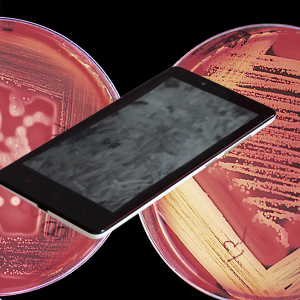Cell Phone Hygiene
 It’s a well-known fact that cell phones are dirty objects, but just how unclean are they? Each square inch of your cell phone contains roughly 25,000 germs, making it one of the filthiest things you come in contact with on a daily basis. That’s something to think about the next time you press your face to your phone. Dr. Charles Gerba, a professor of microbiology at the University of Arizona, says this is not surprising. “Nobody ever cleans or disinfects their phone, so the germs and bacteria just keep building up. The germs that accumulate on the phones include E. coli, as well as influenza and MRSA, a germ that causes rashes and skin infections.”
It’s a well-known fact that cell phones are dirty objects, but just how unclean are they? Each square inch of your cell phone contains roughly 25,000 germs, making it one of the filthiest things you come in contact with on a daily basis. That’s something to think about the next time you press your face to your phone. Dr. Charles Gerba, a professor of microbiology at the University of Arizona, says this is not surprising. “Nobody ever cleans or disinfects their phone, so the germs and bacteria just keep building up. The germs that accumulate on the phones include E. coli, as well as influenza and MRSA, a germ that causes rashes and skin infections.”
Frequent use of our cell phone causes them to remain warm, creating the ideal breeding ground for bacteria. Now that many phones have touch screens, the germs are easily spread from your phone to your hands and face, increasing your chance of infections. Keeping your phone in a warm place such as your pocket or a purse, just acts as a petri dish for the bacteria to grow.
An article in the Annals of Clinical Microbiology and Antimicrobials explored some of those terrifying germs and summarized details from a study involving 200 phones. The researchers found that “94.5% of the phones were contaminated with some kind of bacteria, many of which were resistant to multiple antibiotics.” By also testing the participants’ hands, the researchers were able to show that about 30 percent of the bacteria on the phones ended up on the owner’s hands.
So what to do? Keep a pack of handy anti-bacterial wipes on your kitchen counter or in your car. Thoroughly wipe your phone once a day to ensure you are keeping your phone clean and decreasing the chance of transmitting germs to your body.
[cws_button type=default size=mini link=http://www.wholeness.com/blog ]Back to Blog Home[/cws_button]
REFERENCES:
Fatma, U., Saban, E., Ahmet, D., Keramettin, Y., Murat, G., and Hakan, L. (2008). Are we aware how contaminated our mobile phones with nosocomial pathogens? Annals of Clinical Microbiology and Antimicrobials V Volume 8:7.

Leave a Reply